When I helped create WPBeginner’s online video course portal, the team and I spent countless hours trying to find the perfect software and tools to do the job easily. Along the way, I learned that having the right course creation software can make or break your success.
But here’s the thing – choosing the perfect fit for your online course isn’t easy. The market is flooded with options, each claiming to be the perfect solution.
That’s why I’ve spent a lot of time thoroughly testing many different solutions. I looked at everything from course creation platforms and marketing software to budget-friendly recording and editing tools.
Whether you’re looking to create your first course or want to upgrade your existing setup, I’ve done the heavy lifting for you. I’ve narrowed it down to the best course creation platforms that actually deliver results, ranked and reviewed based on real-world testing, ease of use, and business impact.

Quick Picks – The Best Course Creation Software and Tools
Need a quick overview? Here are some of my top picks for course creation software and tools:
How I Test and Review Course Creation Software and Tools
At WPBeginner, we review course creation tools by using them ourselves and looking at how they work in real-life situations. We focus on the features that really matter for building and selling online courses.
Here’s how I reviewed each tool for this roundup:
🛠️ Ease of Use – I timed how long it took to set up a basic course, upload a video lesson, and integrate with an email marketing service. I looked for intuitive interfaces and clear documentation to ensure a smooth experience for beginners.
📚 Course Creation Features – I checked how well the tool organizes learning materials and supports interactive, engaging courses.
🙌 Student Engagement & Support – I assessed features like quizzes, forums, and social tools that keep students engaged, plus the quality of customer support.
💰 Pricing & Value – I compared cost vs. features to see if the tool is worth it, including free trial options.
🌎 Real World Usage – Apart from the tools I’ve used for creating my own online courses, I tested each platform by creating a short sample course, including uploading videos, creating quizzes, and setting up student access. I also read real user reviews and testimonials to get a more complete picture of each tool’s pros and cons.
Why Trust WPBeginner?
WPBeginner is the largest free WordPress resource site. For over 16 years, we’ve been helping thousands of entrepreneurs build and grow their businesses.
But we’re also big fans of online course creation.
Drawing from our firsthand experience with our free video tutorials, we’re passionate about supporting educators in running their own online course platforms. And, of course, make it easy for everyone!
Our recommendations for course creation software and tools come from real-world experience and thorough testing. We’ve also learned a ton from creating and managing our own online resources.
Our goal? To help you find the best solutions for your online course, backed by data and honest recommendations. You can learn more about how we test and review products in our complete editorial process.
Here’s a quick overview of all the software and tools I’ll share in this guide:
With that in mind, here’s my curated list of the best course creation software and tools.
Best Online Course Creation Platforms
Creating an online course involves more than just content creation. You need a platform that makes it easy to host, sell, and manage your courses while providing a seamless learning experience for your students.
Why I Recommend WordPress for Your Online Courses
I highly recommend using WordPress to create and sell your online courses.
🚨 But first, it’s important to understand the difference between WordPress.com and WordPress.org. I recommend using WordPress.org to host your courses.
Why? WordPress.com is a hosted platform that is easy to use but has some customization limitations. On the other hand, self-hosted WordPress.org offers complete control over your website and course content.
It allows you to install a learning management system (LMS) plugin and turn your WordPress website into a feature-rich online course platform. You will also have complete control over your branding, pricing, and content.
For more information about the platforms, you can see our comparison article on WordPress.com vs. WordPress.org.
At WPBeginner, we’re big fans of WordPress.org. Our team has been using it for more than 16 years and loves how much freedom it offers and how easily it can handle complex data.
To get started with WordPress, you’ll need web hosting and a domain name.
You can think of web hosting as renting space on the internet for your course website.
Then, you’ll need to get a domain name, which is your website’s address. It’s how people will find your site online, so you’ll want to choose something catchy and easy to remember.
For tips, you can see our guide on how to choose a domain name.
Bluehost is a great option for both of these things because they are beginner-friendly and reliable. Plus, they offer a huge discount on their hosting to WPBeginner readers + a free domain name for the first year.
Their packages also come with a free SSL certificate, which is great for making your online course site more secure and trustworthy.


Basically, you can build an online course site starting from $1.99 per year.
Just click on the button below to get started.
To learn more, you can see our article on how to install WordPress, which covers steps for other WordPress hosting providers like SiteGround and Hostinger, too.
Once you have WordPress set up with your hosting and domain, you can start building your website. You can also find tons of plugins and tools available to help you create your course and make it awesome for your students.
With all that said, I will also look at some non-WordPress options for creating and sharing your online courses. Let’s explore my top picks.
1. MemberPress
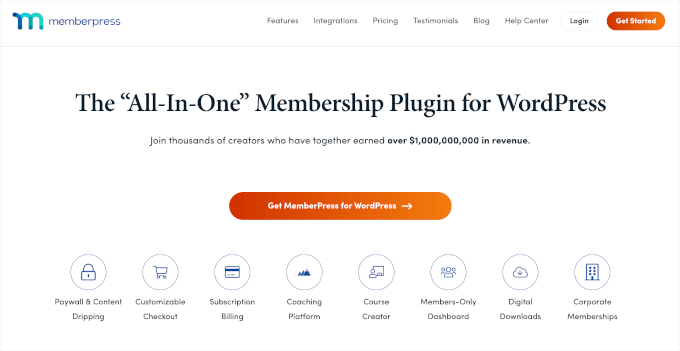

MemberPress is the perfect all-in-one course creation solution for beginners. It offers an easy-to-use learning management system (LMS) with powerful features for building and managing a members-only, paid course platform.
At WPBeginner, we personally use MemberPress to power our free online video courses, and we love how easily it lets us set up student access rules. For more details, see our guide on how we use a video membership site to grow our email list.
To create courses with MemberPress, you can use 2 powerful addons: Courses and CoachKit.
MemberPress Courses lets you easily create and manage your online courses. It uses the WordPress block editor, which makes it simple to build and structure your lessons. You can also add multimedia content like videos and audio to engage your students.
Its Classroom Mode is designed for a distraction-free learning experience. It features intuitive navigation to help students move through the course easily. There’s a course overview and instructor details for quick reference. Plus, the progress bar helps students track their learning journey and stay motivated to complete the course.
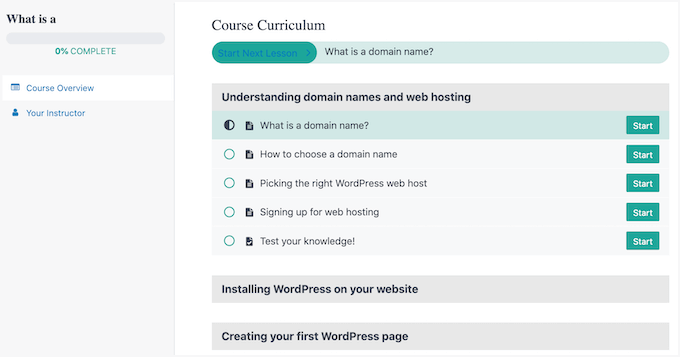

MemberPress Courses comes with extra addons, such as:
⁉️ Quizzes: Let students test their knowledge and reinforce what they’ve learned. There are many quiz types to choose from, like short answers, multiple choices, true/false questions, and more.
📄 Assignments: Give students a way to submit their work after each lesson, whether it’s written responses or projects.
🌟 Gradebook: Easily track progress and manage grades all in one place.
There’s also the content-dripping feature to release lessons gradually instead of all at once.
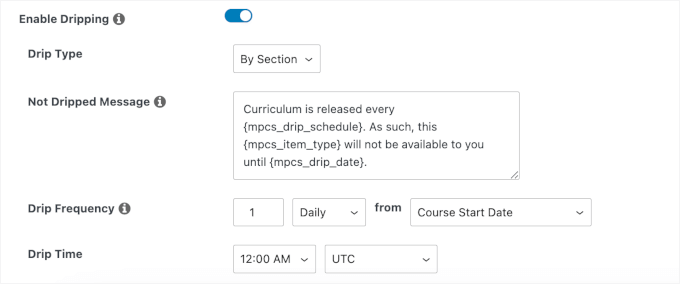

You can also use MemberPress CoachKit, which is perfect for offering one-on-one coaching or group sessions. It lets you manage coaching schedules, track student progress, and provide a more personalized learning experience.
To learn more about it, see our guide on how to start an online coaching business.
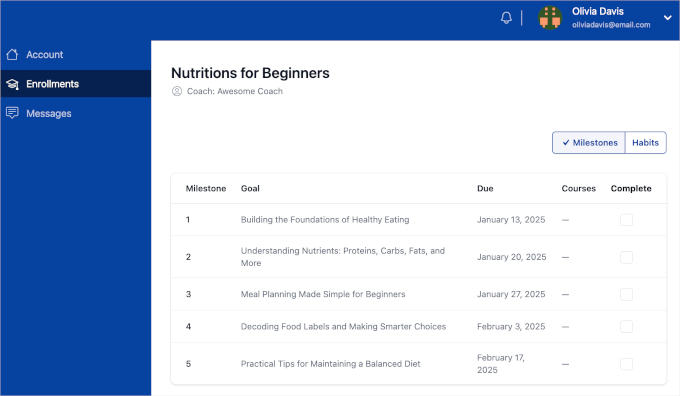

Another great thing about MemberPress CoachKit is that it allows you to offer WordPress group learning with the ‘Cohorts’ feature.
It’s a structured learning experience where participants progress together with set start and end dates.
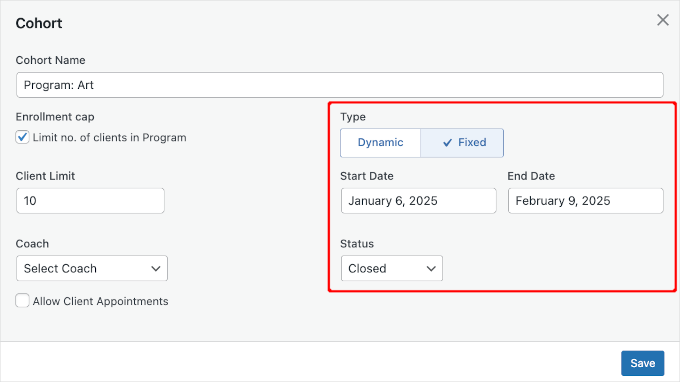

This format encourages a sense of community, improves accountability, and allows students to interact with both instructors and peers.
If you want to offer certificates, then you can do that too!
MemberPress allows you to enable certificates on your courses. Even better, you can customize the details, such as the paper size, design choice, and custom logo.
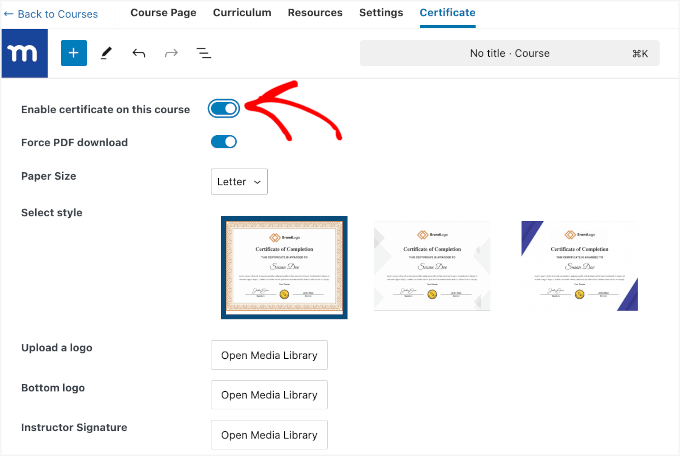

On top of all that, MemberPress is a membership plugin, so you’ll get access to features like paywalls, custom access rules, and members-only forums. For details, see this complete guide on how to create a membership site with WordPress.
Pros
Powerful LMS features with Courses and CoachKit addons.
Distraction-free Classroom Mode with intuitive navigation, overview, and progress tracking.
Flexible course creation and management with multimedia, quizzes, assignments, and grade books.
Supports one-on-one coaching as well as group learning.
Drip content for scheduled course releases.
Includes certificates with customization options.
No transaction fees with the Basic plan.
Cons
Requires the Courses and CoachKit addons for full LMS functionality.
Pricing may be high for small online course projects.
Pricing: MemberPress offers 4 pricing plans. The Basic plan starts at $179.50 per year and allows for unlimited members and no transaction fees. The Elite plan offers a coaching integration with CoachKit, which is perfect for those wanting to offer personalized coaching alongside courses.
Why I Chose MemberPress: I strongly recommend MemberPress because it’s an all-in-one solution for creating and selling online courses and coaching sessions. Its Courses and CoachKit addons make it easy to create engaging learning experiences, while the ‘Cohorts’ feature boosts student interaction and accountability.
2. Thrive Apprentice
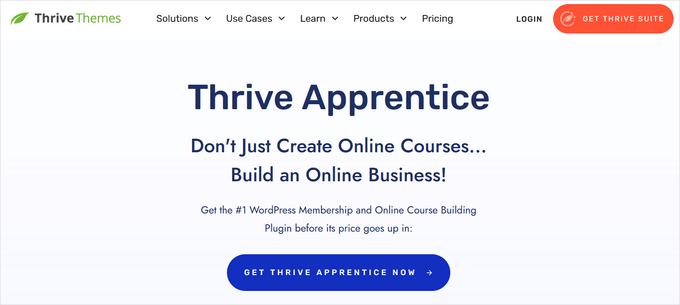

Thrive Apprentice is a WordPress LMS plugin that stands out for its powerful School Wizard visual editor. This feature makes designing and customizing your online courses very easy. Overall, it’s a great all-in-one solution for creating and managing courses and memberships – no coding needed.
I tried out all of Thrive Apprentice’s features to see how it compares to other online course creation software. For more details, you can see this complete Thrive Apprentice review.
During onboarding, I liked that the course builder lets you choose from 55 templates and then quickly customize them using drag and drop.
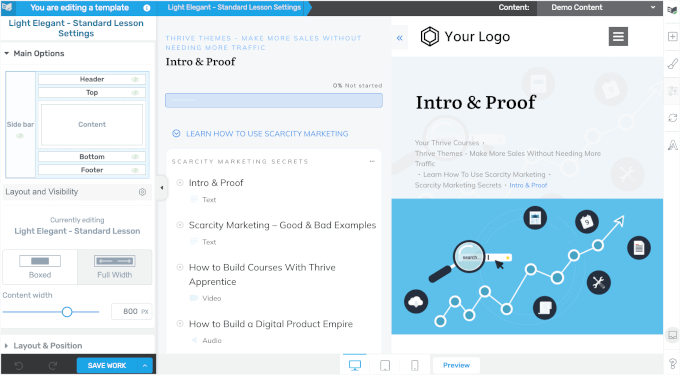

Don’t want to use a template? Then you’ll appreciate the School Wizard.
This feature walks you through setting up your online course from scratch with a step-by-step checklist. It helps you create a more unique, personalized result that aligns with your brand.
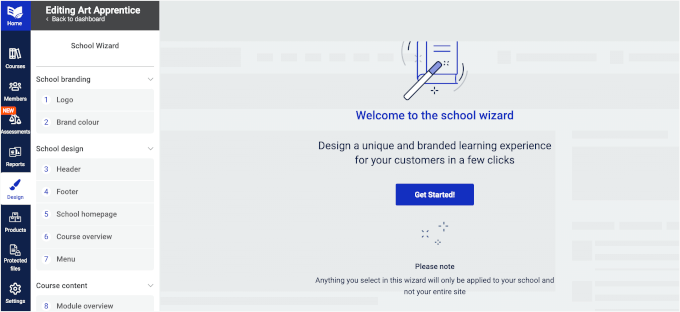

To keep learners engaged, you can create lessons in different formats, including text, video, and audio. Plus, you can add extra resources like PDFs, links, and lesson summaries.
The good news is that combining these formats gives students the flexibility to learn in a way that works best for them.
You can then organize your lessons into chapters and group chapters into modules. This helps you create a clear and structured course layout.


I also like that Thrive Apprentice lets you lock content on a drip schedule or based on specific actions.
This way, students might need to finish a lesson or pass a test to access the next part of the course, encouraging progressions.
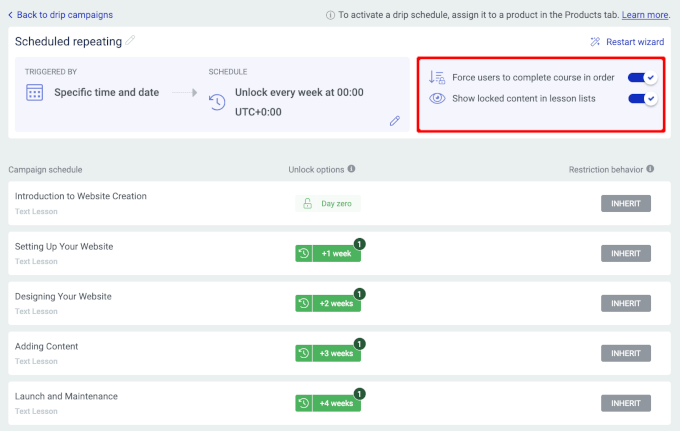

I also appreciate the course-level grading feature in Thrive Apprentice. It lets you assign and calculate overall grades based on student performance across different assessments.
You can customize how each assessment contributes to the final grade, set flexible weightings, and define custom grade ranges and labels.
Even better, these grades will appear on students’ course certificates, like this:


Additionally, Thrive Apprentice gives you access to over 6 million high-quality, royalty-free stock photos from Unsplash. This makes it easier to add engaging visuals to your course lessons and sales pages.
On top of all that, student management is easy with Thrive Apprentice’s built-in dashboard. Here, you can control course access, track student progress, and review a complete log of their activities.
Pros
Easy-to-use visual editor, with the School Wizard option to create your online course from scratch and 55 ready-made course templates.
Text, video, audio, and mixed course format support.
Structure courses into lessons, chapters, and modules.
Ensure course progression through content locking or a drip schedule.
Course-level grading with customizable weightings and grades shown on certificates.
Unsplash access to easily add engaging images without leaving Thrive Apprentice.
Built-in dashboard to manage students and track progress.
Cons
Fewer built-in payment gateways for accepting payments from your students.
Pricing: Thrive Apprentice is available for $149 per year, which is perfect for adding online courses to an existing site. However, for people launching a new website or business, we recommend the Thrive Suite for $299. It includes all the Thrive plugins for designing, building, and growing a successful site.
Why I Chose Thrive Apprentice: I like Thrive Apprentice because it’s perfect for course creators who want an easy setup, thanks to its visual builder and ready-made templates. It’s a flexible, scalable solution for building and managing online courses.
3. Courses for MemberMouse
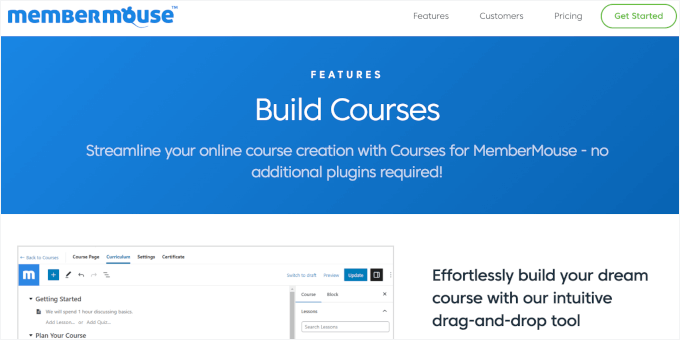

If you’re serious about making money from your online courses, then Courses for MemberMouse is a reliable option. It’s another WordPress LMS plugin, but it stands out for how well suited it is to enterprise-level businesses.
I tried out all of MemberMouse’s features, which you can see in this complete MemberMouse review.
Courses for MemberMouse lets you easily build and sell online courses using a drag-and-drop builder, making it beginner-friendly with a low learning curve.
A standout feature is the ability to restrict access to specific courses or lessons, similar to MemberPress. You can restrict lessons or courses based on memberships, bundles, or sales packages, keeping your material secure and exclusive.
The Classroom Mode automatically applies a professional, customizable template. It lets you brand your courses with your custom logos, colors, and images for a cohesive look.
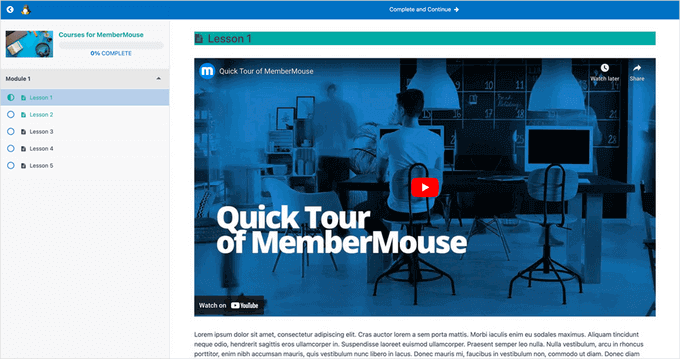

Courses for MemberMouse also offers several tools to improve the learning experience.
For example, progress-tracking bars and lesson navigation prompts help students stay on track and know exactly where they are in the course.
To test students’ knowledge, you can use a variety of quiz options, such as multiple-choice and long essay questions.
Once students complete a course, you can reward them with downloadable, customizable certificates to recognize their achievement.
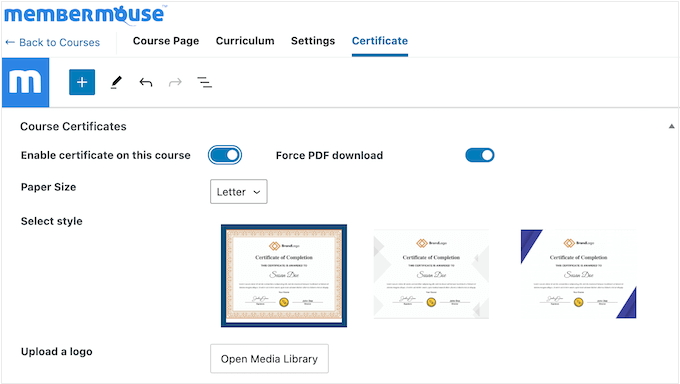

To streamline online course sales, Courses for MemberMouse offers one-click purchase links so learners can quickly complete their transactions without having to re-enter their payment details. You can also offer cross-sells to promote multiple online courses more effectively.
On top of that, MemberMouse has some great features for growing your business. I discovered that it tracks important business metrics, including lifetime customer value and churn rates. It even processes overdue payments automatically, so you don’t have to worry about losing sales.
Pros
Ability to restrict access to specific courses or lessons (similar to MemberPress).
Classroom Mode with a progress-tracking bar and lesson navigation for a professional course appearance.
Downloadable certificates for course completion.
One-click purchase links for a streamlined sales process.
A cross-sell feature to promote additional courses.
Flexible access rules for content protection (based on memberships, bundles, or sales packages).
Drip Content Scheduler for gradual content release and structured learning.
Cons
No free plan.
Limited design options compared to other WordPress LMS plugins.
Pricing: MemberMouse offers 4 pricing plans, with the Basic plan priced at $199.50 per year. This plan allows for unlimited membership plans and payment acceptance via Stripe. It also includes access to the Courses for MemberMouse extension, making it an excellent choice for creating a successful membership site.
Why I Chose Courses for MemberMouse: I recommend Courses for MemberMouse because it offers a lot of built-in features for making money from your online courses. The drag-and-drop builder, combined with course access restrictions and one-click purchases, makes it an ideal choice for membership site owners looking to grow.
🚨 Alternative: WishList Member is another great option for protecting content and offering tiered access to your students. For details, you can check out this WishList Member review.
4. AccessAlly
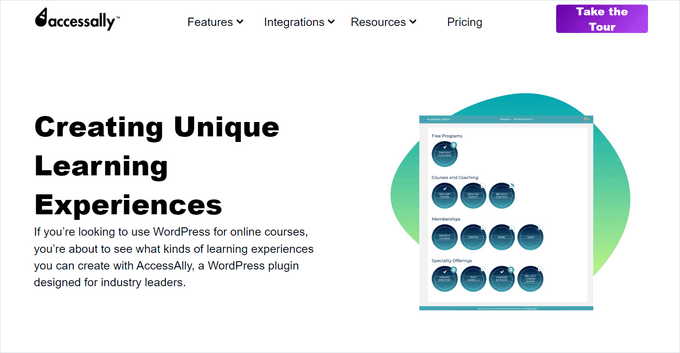

If you want to scale your online course, group coaching, or membership business, then I think that AccessAlly is a great option. It stands out for its strong community-building features and seamless CRM integrations.
One of AccessAlly’s standout features is CommunityAlly. This powerful add-on creates a space for students to connect, collaborate, and engage.
In my opinion, this feature is key to building a strong and engaged community across your online course programs.
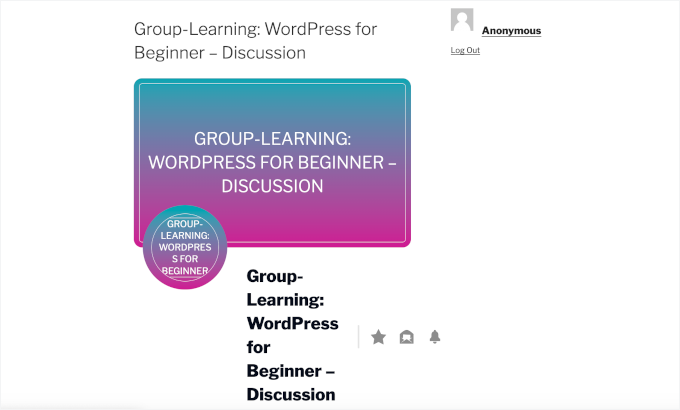

I also really liked its seamless integration with different email marketing CRMs like Kit and Drip, along with eCommerce payment gateways, WordPress themes, and other WordPress plugins. Essentially, AccessAlly lets you handle almost everything from one place, from accepting payments for your online courses to keeping in contact with your students.
Using AccessAlly is also easy, thanks to their drag-and-drop course builder. Plus, you can mix and match modules, lessons, and downloadable resources.
To make the setup even easier, AccessAlly’s Offerings Wizard walks you through the entire process step by step. Then, it automatically generates all the essential course pages – landing pages, module and lesson pages, registration pages, and even a completion page.
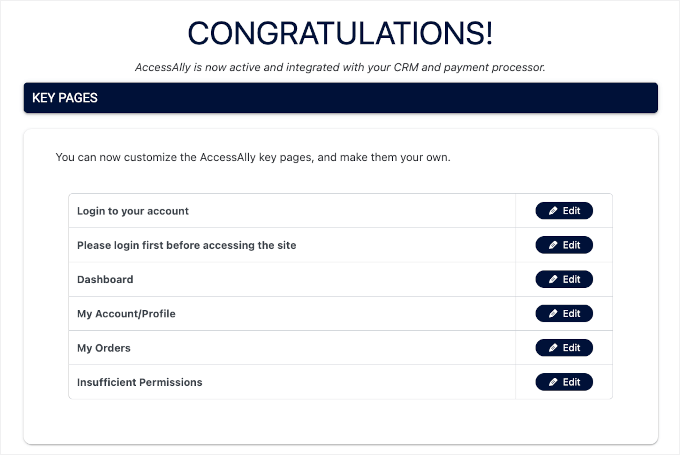

Lastly, AccessAlly offers excellent progress-tracking features that allow you to set objectives for each lesson or module, such as passing a quiz. This ensures that students stay on track and motivated as they move through the course.
Just keep in mind that AccessAlly is a little more expensive than other WordPress LMS plugins on this list. That’s why I recommend it for growing businesses that want to scale.
Pros
CommunityAlly lets you build an engaging, collaborative student community.
Seamless and extensive integrations with email marketing software, eCommerce shopping carts, and themes.
Drag-and-drop builder with an Offerings Wizard for quick setup.
Automatically generate all necessary course pages, saving you time on setup.
Progress tracking with customizable objectives, like quiz completion, to measure student progress.
Flexible course types, including live, evergreen, and progress-based courses.
Cons
Higher price compared to some LMS plugins.
Pricing: AccessAlly starts at $82/month (billed annually) for one site with unlimited courses and members. The LMS features require the Pro plan at $108/month (billed annually).
Why I Chose AccessAlly: I recommend AccessAlly if you’re looking to scale your online courses or coaching programs. It gives you all the tools you need to create a powerful online learning community and monetize your courses.
5. YouTube
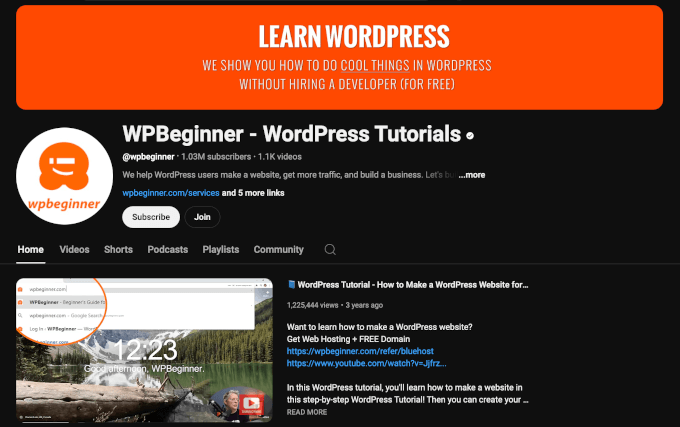

YouTube is a popular, free platform for hosting video-based courses. In addition to public videos, you can offer members-only content through the Memberships system. This makes YouTube a great solution for reaching a wide audience while controlling access to your content.
At WPBeginner, we have our own WPBeginner channel where we share helpful content and tutorials for both free and paid users. We’ve had tremendous success with YouTube and continue to manage several channels for different businesses.
But you might still be asking yourself why YouTube is a good platform for video courses.
First, it’s free to use, making it accessible to anyone who wants to create and share videos. You can upload unlimited content, and it’s easy for students to access courses from anywhere. Plus, YouTube’s massive audience gives you the potential to reach people worldwide.
For details, see this guide on how to start a successful YouTube channel.
Plus, if you turn on Memberships for your channel, then you can offer exclusive perks such as custom emojis, badges, and members-only videos. You can create up to 6 membership levels, with higher-priced tiers unlocking all the perks from the lower levels.
Another great feature of YouTube is its built-in SEO capabilities. Optimizing your video titles, descriptions, and tags can improve your chances of ranking higher in YouTube’s search results.
To take it a step further, tools like TubeBuddy can help you fine-tune your SEO strategy. This way, you can grow your channel and reach more viewers.
That being said, YouTube does offer less control than hosting online courses on your own website. Also, while it’s excellent for video delivery, YouTube isn’t designed for complex learning paths, assignments, or detailed progress tracking.
Pros
Free to use with unlimited video uploads.
Easy access for students from anywhere, which unlocks massive audience potential for global reach.
Built-in SEO capabilities for wider discovery.
Channel memberships with multiple tiers for offering exclusive perks.
Cons
Only suitable for video courses.
Lacks course-specific features like quizzes or certificates.
Not designed for dedicated course management.
Less control over branding and customization.
Pricing: Free
Why I Chose YouTube: I recommend YouTube because it’s a free video-sharing platform with a massive global reach. More than 2 billion people use YouTube every month, so it’s ideal if you’re trying to reach a wide audience. Plus, you can monetize your online courses through the Memberships system.
6. Teachable


Teachable is a hosted online course platform that makes it easy to create and sell online courses without worrying about running your own website. Its drag-and-drop course builder helps you get started quickly and easily, allowing you to add videos, quizzes, and downloadable resources.
Since it’s a standalone platform, you don’t have to worry about updates or backups. Teachable will take care of all that, giving you more time to focus on creating content.
I’ve tested Teachable extensively, which you can learn more about in this comparison article on Teachable vs Skillshare vs MemberPress.
Getting started with your first course is simple. Teachable’s AI-powered outline generator helps you develop course materials quickly. Just enter a course title and a brief description, and the AI will immediately make a structured outline for you.
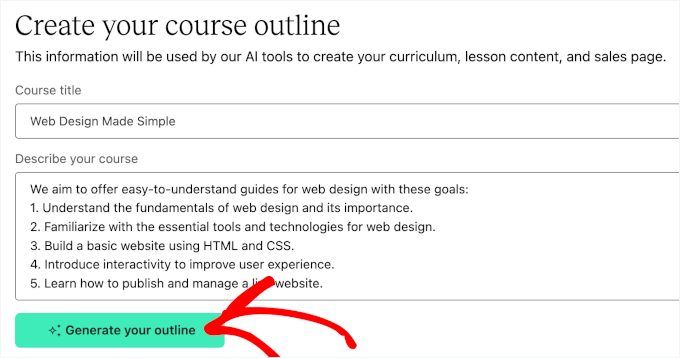

Once the outline is ready, Teachable takes you to the setup guide. Here, you can customize your course layout, add lessons, and make necessary adjustments.
While customizing course design, I found that Teachable offers 2 template options: Simple and Colossal. While this may feel somewhat limiting, you can still adjust these templates to match your brand.
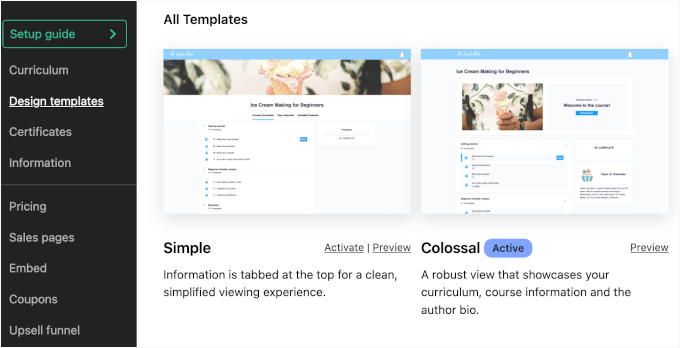

Teachable includes built-in email marketing to help you stay connected with your students. It also generates a sales page automatically, so you can start promoting your courses right away.
I also found that you can track your course performance with analytics, monitor student engagement, and use referral programs to grow your business.
Overall, Teachable is a great choice for course creators who want an easy-to-use, all-in-one platform to build, manage, and sell their courses.
Pros
Hosted platform – no need to manage a website, updates, or backups.
AI-powered tools to generate a structured course outline in just a few clicks.
Built-in email marketing to help you stay connected with students.
Auto-generated sales page for quick promotion of your courses.
Analytics to track course performance and student engagement
Referral programs to help grow your business
Cons
Less control over customization compared to WordPress-based platforms.
Higher transaction fees apply to free and lower-tier plans.
Pricing: Teachable’s free plan is great if you want to try things out before paying. It lets you publish one course, coaching session, or downloadable product, but there’s a $1 + 10% transaction fee on every sale. The Basic Plan, $39/month, billed annually, lets you publish up to five products: courses, coaching, downloads, and the transaction fee drops to 5%.
Why I Chose Teachable: Teachable stands out for its simplicity and power. It’s an ideal platform for course creators who want to build, manage, and sell their courses without technical headaches.
Best Online Course Marketing Tools
Once your online course is ready, it’s time to focus on getting the word out. The right marketing tools can help you attract students, build your brand, and boost enrollment.
Let’s dive into my marketing tool recommendations for your online course.
7. OptinMonster


OptinMonster is a powerful tool for boosting sign-ups to your online courses. It helps you grow your email list and convert visitors into students with features like popups, slide-ins, and lightboxes.
At WPBeginner, we have been using OptionMonster for a while, and it has helped us grow our email lists exponentially. You can learn more about it in our complete OptinMonster review.
With OptinMonster, you can create customized calls-to-action that encourage visitors to sign up and start learning.
With over 400 professionally designed templates, OptinMonster makes it easy to create high-converting popups that match your course branding. You can customize these templates using the simple drag-and-drop builder, and no coding is required.
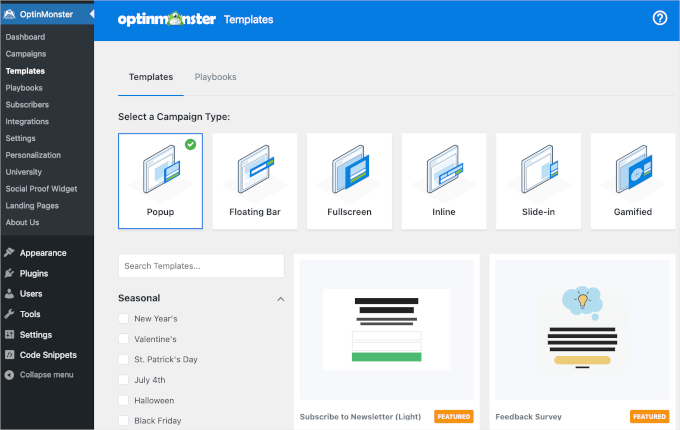

One of its standout features is the countdown timer, which is a perfect tool for promoting your online courses.
For example, you can use it to create urgency for limited-time discounts, early bird offers, or course enrollment deadlines. This motivates visitors to sign up quickly, helping you boost conversions and fill your courses faster.
Another great feature is content locking. It allows you to gate access to certain content or course previews, asking visitors to sign up for your email list before they can view the material.


It’s a smart way to build your email list while giving potential students a sneak peek at what your course offers.
Additionally, I recommend using OptinMonster’s A/B testing feature to test different popup variations and see which ones resonate most with potential learners. By comparing results, you can fine-tune your strategy to improve sign-up rates.
Pros
Boosts student sign-ups and email list growth.
Customizable calls-to-action with 400+ templates.
Simple drag-and-drop builder, no coding needed.
The countdown timer creates urgency for course promotions.
Content locking to gate course access and grow your email list.
A/B testing for optimized conversion strategies.
Cons
Pricing: OptinMonster offers four pricing plans starting at $9 per month, with higher plans unlocking more features. It also provides a 14-day money-back guarantee, giving you time to test the plugin and decide if it’s the right fit.
Why I Chose OptinMonster: I love OptinMonster because it’s an incredibly powerful tool that helps you boost course sign-ups and grow your email list. It comes with customizable popups, advanced targeting features, and an easy-to-use editor. Plus, it allows you to create urgency and test strategies to improve your conversion rates.
8. Canva
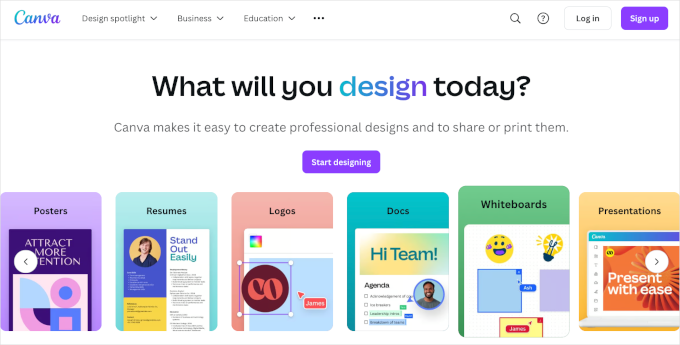

Canva is a fantastic tool for creating graphics and visuals for your online courses, especially if you’re not a designer. Whether you need eye-catching course thumbnails or custom lesson slides, this design software makes it simple to make professional-level images.
One of Canva’s standout features is its library of customizable templates, which cover everything from lesson slides to social media posts. This makes it easy and quick to create visuals that match your course branding.
I also like that Canva offers a wide range of royalty-free stock photos, illustrations, and icons for your designs.
While some premium resources are available with Canva Pro, the free version offers plenty of options to get started. If you want more unique graphics, though, the paid version could be worth it.
Finally, Canva’s mobile app lets you create and edit designs on the go, making it easy to work on your course visuals whenever inspiration strikes.
Pros
Easy to use for beginners and non-designers.
Tons of customizable templates for course thumbnails, lesson slides, and promotional materials.
Access to an extensive number of royalty-free stock photos, illustrations, and icons.
Design on the go with Canva’s easy-to-use mobile application.
The free version provides plenty of design options.
Cons:
Some resources are only available in the Pro version.
Pricing: Canva‘s free plan includes basic features, such as access to over 250,000 templates and thousands of photos, graphics, and fonts. The pro version starts from $12.99 per month (or $119.99 per year). This plan includes additional features like 100+ million premium stock photos, videos, audio, a brand kit, and more.
Why I Chose Canva: I recommend Canva because it’s an intuitive, user-friendly design tool that allows anyone to create professional-looking course materials. Its vast library of templates and resources, combined with powerful customization options, makes it a top choice for creating engaging visuals for your online courses.
9. Google Slides
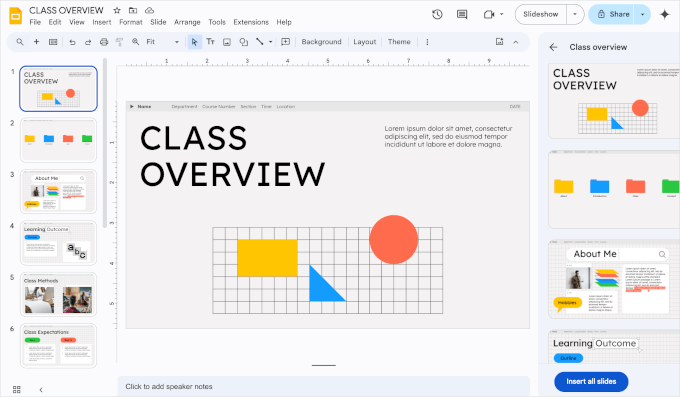

Google Slides isn’t just for presentations. It’s also a powerful tool for designing and delivering your online courses. With its sleek templates and easy customization, you can create visually appealing course previews, lead magnets, and sales materials that attract potential students.
As a course creator, you can use Google Slides to design engaging lesson breakdowns, highlight key takeaways, and create interactive slides that boost student engagement.
Plus, it’s easy to share. You can embed slides on your WordPress site, include them in email campaigns, or use them in free mini-courses to showcase your expertise.
For even more impact, you can repurpose your slides as downloadable PDFs or promotional materials for platforms like Udemy, Teachable, or your own student membership site.
Best of all, Google Slides is free, with a premium version available for extra features and flexibility. If you’re looking for a simple yet effective way to create and market your online course content, then this tool can be a game-changer.
Pros
Free for personal use with a Google account.
Customizable templates for creating visually appealing course materials easily.
Ideal for creating course previews, lead magnets, sales materials, and interactive lessons.
Simple to embed on WordPress websites, include in email campaigns, or integrate into mini-courses.
Convert slides into PDFs or promotional materials for various platforms like Udemy or Teachable.
Cons
Some advanced features are only available with a paid plan of Google Workspace.
Limited offline access without a stable internet connection.
Pricing: Google Slides is free for personal use with a Google account. For businesses, Google Workspace subscriptions start at $6 per user per month, with higher costs for larger packages. A free trial is also available.
Why I Chose Google Slides: While often overlooked, Google Slides is an excellent choice for course creators who want to design professional, engaging learning materials without the need for complex software.
🚨 Alternative: Looking for a way to create beautiful and professional-looking lead magnets for your online course? Check out this detailed Beacon review to learn more about this powerful lead-magnet builder.
Best Online Course Communication Tools
Effective communication is key to creating a successful learning experience. You will need to stay connected with your students, provide support, and keep them engaged throughout their course journey.
Here are my top choices for communicating with students.
10. Constant Contact


Constant Contact is a powerful email marketing tool that can help you engage with your learners. For example, it allows you to personalize course emails and send them at the perfect time for engagement, keeping students informed and motivated throughout their learning journeys.
After thorough testing, I found that Constant Contact is a great choice for engaging students and growing your eLearning business.
With advanced segmentation and detailed reports, Constant Contact makes your email campaigns more targeted. You can group your audience based on course enrollment, progress, or past interactions, ensuring every message feels relevant.
Another standout feature is its automated drip campaigns. You can use this feature to create a welcome series for new students, making onboarding smooth.
Or you can use it to schedule lesson reminders based on the course timeline. It’s also a good idea to trigger follow-ups when someone finishes a module but hasn’t started the next one.
Automating actions based on student behavior is easy, too. For example, if a learner abandons their cart before enrolling, then you can send a follow-up email with a special discount.
Likewise, if someone hasn’t accessed their course in a while, you can send a re-engagement email with study tips or bonus materials to encourage them to return.
Pros
Segment your audience based on course enrollment, progress, past interactions, or other categories to ensure relevant messaging.
Set up automated email sequences like a welcome series, lesson reminders, and follow-ups based on student activity.
Automates actions like sending discounts for cart abandonment or re-engagement emails for inactive learners.
Reports to track email campaign performance and student engagement.
Cons:
Email formatting can be a bit tricky for beginners.
It has basic email analytics compared to some other options.
Pricing: Constant Contact offers a 60-day free trial, allowing you to send up to 100 emails and build your email list before committing to a paid plan. Their pricing starts with the Lite plan at $12 per month. This lets you send 10x your contact number in monthly emails and get access to professionally designed templates, automated welcome emails, and engagement reporting.
Why I Chose Constant Contact: I recommend Constant Contact due to its powerful yet beginner-friendly email automation features that can help you re-engage learners. Its 60-day free trial allows you to test its capabilities, and the automated drip campaigns make it easy to communicate with your students.
11. WebinarJam


WebinarJam is a popular tool for hosting live webinars, and I recommend it for course creators who want to connect with groups of their students online.
We actually use WebinarJam for our own WPBeginner live workshops, and we’ve had a good experience. Our team has found WebinarJam’s interface simple to navigate, especially when hosting basic webinars or live learning sessions.
This software offers features such as unlimited live webinars, multiple hosts, live chat, webinar recordings, polls, and surveys. It also has email and SMS marketing tools, which allow you to follow up with learners after the live session has ended.
With WebinarJam, you can also find features like flexible scheduling, attendee handouts, and broadcasting to Facebook and YouTube. Plus, you can register extra team members, making it ideal for organizing online events of any size.
However, it can take some time to learn all the features, especially if you’re new to webinars. That learning curve can be a little intimidating for beginners.
Pros
Interface for hosting basic webinars.
Unlimited live webinars and multiple hosts.
Includes live chat, webinar recordings, polls, and surveys.
Email and SMS marketing tools.
Flexible scheduling and attendee handouts.
Broadcasting to Facebook and YouTube.
Option to add extra team members.
Cons
Learning curve for new users.
Video quality could be better.
Automating webinars requires an extra service (EverWebinar) at an additional cost.
Pricing: WebinarJam is a premium tool. Its plans start from $39/month, billed annually, and they’re great for smaller webinars. The tool allows up to 100 attendees per webinar with one host.
Why I Chose WebinarJam: I recommend WebinarJam because it offers powerful features that make hosting live webinars seamless and engaging. With unlimited webinars, multiple hosts, and interactive tools like live chat and polls, it’s perfect for connecting with students.
12. Google Meet


Google Meet is a great choice for coaching or one-on-one learning due to its ease of use and integration with Google Workspace. What I love about this tool is that it allows you to set up video calls quickly, share your screen, and collaborate seamlessly using tools like Google Docs and Sheets.
All these tools make Google Meet ideal for personalized coaching sessions or learning experiences where real-time interaction and content sharing are essential.
It’s also free to use for meetings up to 60 minutes and 100 participants, which should be more than enough for many online courses. You can read more about it in our comparison article on Google Meet vs Zoom: Which Is Better for Your Business?
Just keep in mind that it doesn’t have specific features for online courses, so it’s more of a communication medium.
Pros
Easy to use with quick video call setup.
Seamless integration with Google Workspace – Docs, Sheets, Slides, and more.
Free plan for meetings up to 60 minutes with 100 participants.
Ideal for personalized coaching and real-time collaboration.
Cons
Limited to 60-minute meetings on the free plan.
Fewer features compared to some other webinar tools.
Pricing: Google Meet offers a free plan, which allows unlimited one-on-one meetings and group meetings lasting up to 60 minutes with a maximum of 100 participants. For those needing more features, the Google Workspace Essentials plan is available for $8 per user per month. This plan supports group meetings with up to 150 participants and additional features like custom meeting links and file sharing.
Why I Chose Google Meet: I chose Google Meet because it offers a free and easy way to call your students and even host group calls.
13. Facebook (Group)
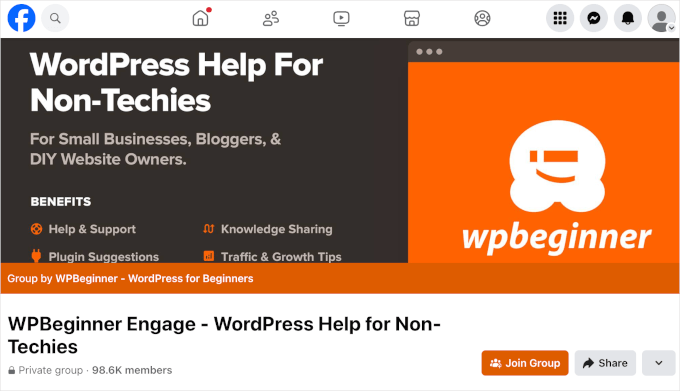

A Facebook group can be a great place to connect with your learners, offer support, and create a sense of belonging. You can also engage with new students who are just discovering your course.
For example, we have the WPBeginner Engage Facebook group with more than 98,000 active members. WordPress users can post their questions and get help with WordPress, interact with each other, and more.
Facebook groups let you promote your content, share updates, and even host discussions. For course creators, they’re a great way to build a learning community. You can create a space where your students can interact with each other, ask questions, and get extra help.
It’s also a perfect forum for group learning because it allows you to post lessons, answer queries, and foster engagement in a more personal way. Plus, you can keep your community active and engaged, helping students stay motivated throughout the course.
However, while Facebook Groups are free to create and use, it’s good to keep in mind that you don’t have full control. Since the platform sets the rules, there’s always a small chance your group could be limited or removed.
Pros
Facebook groups are completely free to create and use.
Great for building a learning community where students can get extra help and support.
Gives you a space for content promotion, sharing updates, and hosting discussions to boost the learning experience.
Provides a platform for learners to connect, ask questions, and engage with each other, creating a sense of belonging.
Cons
Subject to Facebook’s terms of use and algorithm.
File sharing limitations.
Pricing: Creating a Facebook group is completely free.
Why I Chose Facebook (Group): A Facebook Group provides an easy, cost-effective way to build a vibrant, engaged community. Plus, it’s free, making it an accessible option for course creators looking to enhance engagement without breaking the budget.
Best Online Course Recording and Editing Tools
If you’re thinking about offering video learning, then creating high-quality videos is key to engaging your audience.
Let’s check out the best camera, microphone, and editing software for your video courses.
14. Sony Alpha ZV-E10


We have a professional video team here at WPBeginner, and they consistently recommend the Sony Alpha ZV-E10 for course creators looking to capture high-quality video content. I decided to put it to the test and discovered that it has excellent autofocus. This ensures that your shots stay sharp even if you’re moving around during your recordings.
The ZV-E10 doesn’t impose any time limits on your recordings, so you can film extended lessons or tutorials without interruption. However, keep in mind that your recording time will ultimately be limited by the capacity of your memory card and the battery life of the camera.
For longer sessions, make sure you have a large enough memory card and consider having a spare battery on hand. You can also power the camera via USB-C while filming, which is super handy for those marathon recording days.
I also really like that it can shoot in 4K. This is especially important for online courses, where clear visuals can make a huge difference in the learning experience.
Another feature that I appreciate is the ability to connect the camera to a computer via USB-C and use it as a webcam without any additional software. This is great for live teaching sessions, webinars, or video conferences.
Despite all these pro-level features, the ZV-E10 is still budget-friendly for a starter camera. It’s an excellent choice for course creators who want top-notch video quality without overspending.
Pros
Excellent autofocus for sharp and smooth focus, even during movement.
No recording limits – record continuously without worrying about time constraints.
Stunning 4K video support for professional-quality content.
USB-C charging while recording, perfect for long sessions.
Seamless webcam integration via USB-C without any additional software.
Budget-friendly – great features at an affordable price.
Cons
If you’re filming without a tripod, videos might be a bit shaky because there’s no built-in stabilization.
The camera might get too hot during long 4K videos.
Pricing: Starts at $645, depending on the color option and any addons included at checkout. For example, the white model is priced at $798, and you can bundle it with extras like a microphone, lens, or tripod.
Why I Chose Sony Alpha ZV-E10: Its excellent video quality, combined with user-friendly features for content creators, makes the Sony Alpha ZV-E10 stand out. It offers 4K video recording with reliable autofocus, great for capturing professional videos. Plus, it has a great balance of cost and features, perfect for those who want good value for their investment.
💡 Expert Tip: A stabilizer like the Rode Vlogging Kit can keep your videos steady while also improving sound with its built-in mic.
Good lighting is just as important. The Sensyne 10” Ring Light offers adjustable brightness and colors to enhance your indoor shots.
15. Hollyland Lark M1


For a high-quality, budget-friendly wireless microphone, the Hollyland Lark M1 is a top choice for course creators. Our video team uses it for their video content, and it delivers professional sound without the hassle of cords or complex setups.
The Hollyland Lark M1’s built-in noise reduction ensures clear audio in any environment. Whether you’re filming in a busy space or outdoors, your learners will always hear you without distractions.
The charging case keeps your mics powered and ready to go, making it easy to stay charged during long recording sessions. I also like that it is compact and portable, perfect for on-the-go filming.
For live teaching sessions, the 2-transmitter combo lets you mic up two people simultaneously. So, whether you’re teaching with a co-instructor or hosting a webinar with a guest expert, this feature ensures synchronized audio for both speakers.
Plus, the Lark M1 is compatible with many different cameras and smartphones. Whether you’re using a DSLR for polished videos or recording on your phone (both iPhone and Android), you can count on excellent sound.
Pros
Wireless mic with advanced noise reduction for clear, professional audio in any environment.
The portable charging case ensures your mics are always powered and ready for use.
2-transmitter combo allows for simultaneous recording of two people, perfect for interviews or co-teaching sessions.
Broad compatibility with cameras and smartphones (iPhone and Android).
Cons
Limited wireless range may cause audio signal loss in large spaces.
Signal interference in areas with many devices may affect audio quality.
Pricing: The Hollyland Lark M1 offers two microphone setups:
2TX + 1RX (2 Transmitters, 1 Receiver) – Ideal for two-person recordings; starts at $59.00.
1TX + 1RX (1 Transmitter, 1 Receiver) – Best for single-speaker setups; starts at $29.00.
Why I Chose Hollyland Lark M1: The microphone stands out for its affordability and performance. Its compact design and included charging case are convenient, while features like built-in noise reduction help with audio clarity. This makes the Hollyland Lark M1 a practical choice for creators seeking reliable audio without a high price tag.
🚨 Alternative: Røde PodMic is another great option, but it’s more expensive and better suited for advanced users. It delivers professional sound and can be connected to mixers, computers, and your cell phone.
16. Camtasia


Camtasia is a top video editing choice for online course creation, but it’s also versatile enough for other professionals who need dynamic video content. It stands out for its strong screen recording capabilities, perfect for crafting tutorials, presentations, and screen demos.
During testing, I found Camtasia’s video editor to be intuitive and user-friendly. It supports a variety of basic editing features, such as cutting footage, adding transitions, and incorporating effects or annotations.
Camtasia also includes advanced options like animations, cursor effects, and green-screen capabilities. It even has AI-powered tools to make content creation even easier:
🖼️ AI Image Generation – Create unique images for your videos using artificial intelligence.
🗑️ AI-Assisted Background Removal – Easily remove or replace backgrounds in your videos.
🎙️ Natural-Sounding AI Script and Voice Generation – Generate scripts and voiceovers that sound natural and professional. This ensures high-quality audio without the need for a studio setup.
Additionally, you can make your learning videos interactive with features like clickable hotspots, quizzes, and surveys.
Camtasia is available on both Windows and macOS. And you can easily record your screen, voice, and webcam all at once. Importing existing audio and video is easy, too, giving you even more flexibility in creating your content.
Pros:
Comprehensive editing features, both basic and advanced.
Strong screen recording capabilities, ideal for creating tutorials, presentations, and screen demos.
AI image generation, AI-assisted background removal, and natural-sounding AI script and voice generation.
Interactive learning features such as clickable hotspots, quizzes, and surveys.
Allows for the recording of screen, voice, and webcam simultaneously.
Easy importing of existing audio and video tracks.
Available on both Windows and macOS.
Cons:
It can be a bit expensive for beginner course creators.
It has a learning curve.
Pricing: Starts at $179.88/year.
Why I Chose Camtasia: I recommend Camtasia for its outstanding screen recording and video editing capabilities, perfect for online course creation. Its interactive features, like quizzes and hotspots, boost learner engagement. Plus, cross-platform compatibility and easy media importing add flexibility for producing quality video content.
🚨 Alternatives: If you’re looking for a free solution, then Davinci Resolve is a great option. It comes with professional-grade video editing tools and color correction features, which are ideal for course creators who need advanced capabilities without high costs.
Canva also offers a built-in video editor. It’s easy to use, packed with templates, and works on Windows, Mac, iOS, and Android.
For more advanced editing, Adobe Premiere Pro is a top choice. It has AI-powered tools to help automate tasks, making professional-quality video editing more efficient. However, it can be very expensive for beginner course creators.
What Are the Best Course Creation Software and Tools?
When creating and promoting your online courses, choosing the right tools is essential to reaching the right audience and getting more student signups.
The right software can help you design professional-looking courses, engage your students, and even grow your audience. Whether you’re just starting or looking to take your course to the next level, using the best tools in each area can make all the difference.
Here are some of my top recommendations to help you build, manage, and promote your courses effectively:
MemberPress: MemberPress is a powerful and easy-to-use learning management system (LMS) for managing your courses and students. It lets you create and sell online courses, manage memberships, and even set up different access levels for your students.
OptinMonster: Want to attract more students? OptinMonster helps you create popups and other engaging optins to promote your online courses, increase signups, and grow your email list.
Constant Contact: Keeping your students engaged and informed is crucial for a successful online course. Constant Contact lets you send welcome emails to new students, automated lesson reminders, and personalized announcements to keep everyone on track.
Sony Alpha ZV-E10: A fantastic choice for creators who want professional-looking videos without breaking the bank. Its excellent autofocus ensures your videos stay sharp, even if you move around while filming. Plus, you can easily use it as a webcam for live sessions, making it a versatile tool for any course creator.
FAQ About Course Creation Software and Tools
Let’s go through some answers to some common questions about course creation tools and platforms.
Can I make money selling courses online?
Yes, selling courses can be quite profitable, especially if you target the right audience and provide valuable, high-quality content. Your success largely depends on how well you market your course and engage with your students.
Can I sell my course on Udemy?
Yes, you can sell your course on Udemy. It’s a popular platform for course creators because it provides a large audience and handles payment processing, but it also takes a share of your revenue.
What are the best online platforms for online classes?
Some of the best platforms for online classes include MemberPress, Teachable, and Thrive Apprentice. These platforms offer powerful features for creating, marketing, and selling your courses.
Is Teachable the best platform for offering online courses?
Teachable is a great choice for offering online courses due to its user-friendly interface and comprehensive feature set. However, whether it’s the best for you will depend on your specific needs and goals.
I hope this article has helped you find the best course creation software and tools. Next up, you might want to see our guides on how to create and sell online courses and how to run a virtual classroom.
If you liked this article, then please subscribe to our YouTube Channel for WordPress video tutorials. You can also find us on Twitter and Facebook.

